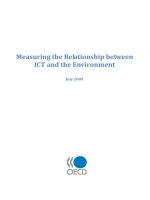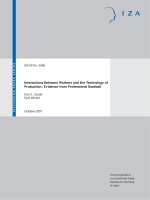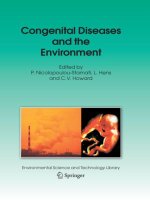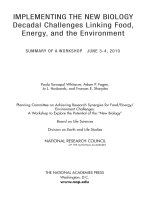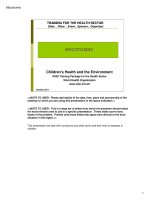Interactions between Aquaculture and the Environment pot
Bạn đang xem bản rút gọn của tài liệu. Xem và tải ngay bản đầy đủ của tài liệu tại đây (2.15 MB, 115 trang )
1
Guide for the Sustainable
Development of
Mediterranean
Aquaculture
Aquaculture and
Interactions between
the Environment
II
The designation of geographical entities in this book, and the presentation of the material, do not imply the expression of any opinion whatsoever on
the part of IUCN, the Spanish Ministry of Agriculture, Fisheries and Food or the European Federation of Aquaculture producers (FEAP) concerning
the legal status of any country, territory, or area, or of its authorities, or concerning the delimitation of its frontiers or boundaries.
The views expressed in this publication do not necessarily reflect those of IUCN, the Spanish Ministry of Agriculture, Fisheries and Food or the
European Federation of Aquaculture Producers (FEAP).
This publication has been made possible in part by funding from the Spanish Ministry of Agriculture, Fisheries and Food
Published by: The World Conservation Union (IUCN), Gland, Switzerland and Malaga, Spain in collaboration with
the Spanish Ministry of Agriculture, Fisheries and Food and the European Federation of Aquaculture
Producers (FEAP).
Copyright: © 2007 International Union for Conservation of Nature and Natural Resources
Reproduction of this publication for educational or other non-commercial purposes is authorized without
prior written permission from the copyright holder provided the source is fully acknowledged.
Reproduction of this publication for resale or other commercial purposes is prohibited without prior
written permission of the copyright holder.
Citation: (2007).
Guide for the Sustainable Development of Mediterranean Aquaculture. Interaction between
Aquaculture and the Environment. IUCN, Gland, Switzerland and Malaga, Spain. 107 pages.
NIPO: 251-07-085-X
ISBN: 978-84-491-0767-2
Legal Deposit:
Design & Layout: Chadi Abi Faraj
Cover photo:
© Guzel Yucel-Gier
Product Management by: Sonsoles San Roman
Produced by: IUCN Centre for Mediterranean Cooperation
Printed by: Solprint, Mijas (Malaga)
Available from:
A catalogue of IUCN publications is also available at www.iucn.org/publications.
The text of this book is printed on recycled chlorine free Cyclusprint 100 gsm
The IUCN Centre for Mediterranean Cooperation
C/ Marie Curie 35
29590 Campanillas, Malaga, Spain
Tel: +34 952 028430 - Fax: +34 952 028145
www.uicnmed.org
Ministerio de Agricultura, Pesca y Alimentación
Secretaria General de Pesca Marítima
C/José Ortega y Gasset, 57
Madrid, Spain
Tel. +34 91 3476164
III
Table of Contents
Foreword v
Executive Summary 1
Introduction to the Guides 11
General Situation of Aquaculture 15
Guide A: Domestication 21
Guide B: Introduced Marine Species 27
Guide C: Capture of Wild Stocks for Aquaculture Needs 33
Guide D: Feed Ingredients 43
Guide E: Organic Matter in the Efuents 53
Guide F: Pathogen Transfer 61
Guide G: Therapeutic and other Products 65
Guide H: Antifouling Products 71
Guide I: Effects on Local Flora and Fauna 75
Annexes
Glossary 82
General Bibliography 86
Bibliography 88
List of Participants 102
List of Acronyms 106
IV
V
Foreword
A
quaculture currently faces a signicant challenge: how to full the
expectation of alleviating the pressure that shing eets exercise
on sh populations and the increasing demand of sea products in local
and international markets without leading to environmental problems.
Particularly, aquaculture is expected to develop widely in the near future,
in the Mediterranean’s European, Southern and Eastern countries. In order
to avoid potential environmental disruption issues, it is important that the
aquaculture sector is provided with clear, user friendly and scientically-
based guidelines to ensure its sustainable development.
The Marine Programme of the World Conservation Union (IUCN) has
been promoting best practices in the aquaculture sector. The IUCN and the
Federation of European Aquaculture Producers (FEAP) signed a common
agreement to cooperate in the development of sustainable aquaculture in
2005. Within this framework, IUCN and the General Secretariat for Fisheries
of the Ministry of Agriculture, Fisheries and Food of Spain (MAPA),
signed an agreement to cooperate and develop “Guidelines for Sustainable
Development of Mediterranean Aquaculture”. The objective of these
guidelines is to propose recommendations for responsible and sustainable
aquaculture, giving support to decision makers, aquaculture producers and
stakeholders in the Mediterranean region. The guidelines will be made up of
a number of individual guides. These guides will address the following issues,
amongst others: The Interaction between Aquaculture and Environment;
Site Selection; Species and Products Diversication; Animal Welfare and
Sanitary-Ethic Aspects; Social Aspects; Food Origin and Quality; Market
Aspects; Aquaculture Management.
The working group, originally named “Aquaculture and Environment”, was
set up in 2004 by IUCN’s Centre for Mediterranean Cooperation, and is
composed of aquaculture specialists from around the Mediterranean region,
VI
with differing areas of expertise. After an initial meeting in 2004, the group
organised a workshop with the Algerian Ecologic Movement (MEA) and
the Algerian Ministry of Fisheries, in Algiers (June 2005). Later, there was a
meeting in Barcelona (November 2005) designed to push forward work on
the results obtained from the Algerian workshop and plan future activities.
This document belongs to a collection of guides that together will make
up the guidelines for the development of sustainable aquaculture; this rst
one is devoted to the interaction between aquaculture practices and the
environment. The document does not address interaction with other human
activities taking place in the same environment. Neither does it cover fresh
water aquaculture, although some examples are taken from this activity.
It addresses nsh and shellsh culture, but mainly focuses on nsh
aquaculture, and specically cage culture.
The present document is the result of a three-day workshop held in Las
Palmas de Gran Canaria (26-28 October 2006) and organised by BIOGES
(University of Las Palmas de Gran Canaria). This workshop gathered 26
participants from most of the Mediterranean countries. There were scientists
and aquaculture producers, as well as representatives of governmental and
environmental organisations (the participants list can be found in Annex).
The compilation of data and drafting of this document have been done
by Alex Makol and Ricardo Haroun (BIOGES), with the participation
of all workshop participants, and under the coordination of Javier Ojeda
(APROMAR/FEAP) and François Simard (IUCN).
Executive Summary
A
quaculture is the farming of aquatic organisms including sh,
molluscs, crustaceans and aquatic plants. Farming implies some sort
of intervention in the rearing process to enhance production, such as regular
stocking, feeding, protection from predators, etc. Farming also implies
individual or corporate ownership of the stock being cultivated.
Most of the potential environmental impacts of aquaculture can be managed
and minimised through the understanding of the processes, responsible
management and the effective siting of farms. Therefore, sustainable
management guidelines are essential tools for policy makers, administrators,
aquaculture producers and other stakeholders. This guide is devoted to
the interaction between aquaculture practices and the environment, in
particular:
Guide A: Domestication
Guide B: Introduced Marine Species
Guide C: Capture of Wild Stocks for Aquaculture Needs
Guide D: Feed Ingredients
Guide E: Organic Matter in the Efuents
Guide F: Pathogen Transfer
Guide G: Therapeutic and other Products
Guide H: Antifouling Products
Guide I: Effects on Local Flora and Fauna
Interactions between Aquaculture and the Environment
Domestication
Guide A
Principle
The domestication of species for aquaculture is necessary.
The interaction of these domesticated organisms with their
wild counterparts should not have negative effects.
Guidelines
About the development of domestication:
• Domestication of aquacultured organisms should
be encouraged.
• Selective breeding of aquacultured organisms
should be designed to reduce their capacity to
survive or reproduce in the wild.
• Research for domestication should be encouraged
and supported.
• The creation of gene banks of wild species should
be encouraged as a reservoir of genetic sources.
About escapement management:
• Aquaculture systems should be designed to
effectively contain organisms and minimise the
possibility of escape.
• Contingency plans should be set up for the
eventuality of escapes.
• Research on surveillance of escaped organisms
should be encouraged.
• Additional preventative measures should be
incorporated for high risk activities such as organisms
transfer, grading and harvesting.
© Arturo Boyra/oceanograca.com
Guide for the Sustainable Development of Mediterranean Aquaculture
Introduced Marine Species
Guide B
Principle
In aquaculture the use of introduced species is highly risky.
The precautionary principle should be applied. Introduction
of species should be carried out only in special cases and
taking all required precautions.
Guidelines
About introduction of species
• Native species should be cultured whenever
feasible.
• The recommendations developed in the ICES Code
of Practices on the Introductions and Transfers of
Marine Organisms (2005) as well as the considerations
and suggestions of the report on Alien Species in
Aquaculture by IUCN (2006) should be followed.
• Regional and international collaboration should be
supported to address transboundary biodiversity
impacts of introduced species as stated in UNEP/
MAP (2005).
About escapement management (see chapter on
Domestication)
© Sherif Sadek
Interactions between Aquaculture and the Environment
Capture of Wild Stocks for Aquaculture
Needs
Guide C
Principle
The stocking of aquaculture farms should not affect
the natural status or viability of wild populations, their
ecosystems or biodiversity in general.
Guidelines
• It is preferable that organisms to be raised in
aquaculture farms should have been produced in
hatcheries.
• Research on the closing of the life cycles of
aquacultured species should be encouraged in order
to be able to produce hatchery reared organisms.
• Research on the sh life cycle and functioning of
the ecosystem should be encouraged.
• The sourcing of individuals for stocking the
aquaculture farms done through their capture from
wild stocks should be exercised in a sustainable
manner.
• The capture of specimens to be used as broodstock
in hatcheries should not distort wild populations.
• Wild stocks from endangered species should not be
used, except for rehabilitation or recovery plans, in
order to maintain biodiversity.
© Guzel Yucel-Gier
Guide for the Sustainable Development of Mediterranean Aquaculture
Feed Ingredients
Guide D
Principle
The production of aquafeeds should be a sustainable
activity. The sourcing of these raw materials should be
environmentally acceptable, and should not have negative
impacts on the ecosystems from which these ingredients
are harvested.
Guidelines
About the origin of raw materials:
• The origin of raw materials should be certied as
sustainable.
About the use of feeds and technology:
• The use of formulated feeds should be
recommended.
• Feed management should be improved.
• Feed production technologies and feed quality
should be improved.
About alternative sources for feed ingredients:
• The use of alternative ingredients should be
encouraged.
• The use of other existing sources of marine proteins
and oils should be encouraged.
• Research on alternative sources for feed ingredients
should be encouraged.
About the optimisation of nutrients:
• The farming of low-trophic level species should be
promoted.
• The integration of aquaculture with other agricultural
farming activities should be promoted.
© François Simard
Interactions between Aquaculture and the Environment
Organic Matters in the Efuents
Guide E
Principle
The organic matter provided by aquaculture farms efuents
should, in quantity and quality, be capable of assimilation
by the ecosystem, thereby not producing negative effects
on the local environment.
Guidelines
About farm management:
• Farms should be managed in order to control the
organic matter efuents from their facilities.
• Feed quality should be understood as essential for
organic matter control.
• Best feeding practices should be applied.
• Fish mortalities should be disposed of properly.
About mitigating the organic efuents and beneting
from organic matter:
• Siting of aquaculture farms should take int account
the effects of organic matter in the efuents.
• The development of recirculation systems should
be promoted.
• Polyculture as a practice that recaptures and gives
value to organic matter should be encouraged.
• The creation of biological systems that absorb
organic matter should be promoted.
• Research to optimise the recovery, disposal and re-
use of solid waste should be encouraged.
© Guzel Yucel-Gier
Guide for the Sustainable Development of Mediterranean Aquaculture
Pathogen Transfer
Guide F
Principle
The possible transfer of pathogens between farmed
organisms and wild stock populations should be
minimised.
Guidelines
• Aquacultured organisms should be kept in the best
possible health.
• Disease outbreaks in aquaculture farms should be
prevented, contained and managed.
• Precautionary measures should be implemented to
prevent disease transfer.
• Special biosecurity measures to limit the introduction
of pathogens in hatchery systems should be
implemented.
• The research and monitoring of diseases in wild
populations in the vicinity of aquaculture areas
should be encouraged.
© BIOGES
Interactions between Aquaculture and the Environment
Therapeutic and other Products
Guide G
Principle
The use of therapeutants should be managed correctly
to minimise possible detrimental effects on the natural
environment.
Guidelines
About the reduction of the use of therapeutants:
• Aquaculture sanitary policies should be based
on appropriated preventative and prophylactic
measures.
• The use of antibiotics as a prophylactic method
should be avoided.
• More effective and safer veterinary medicines should
be made available to the aquaculture industry.
About the proper management of therapeutic and
other products:
• A precise laboratory diagnosis of the diseases should
be established prior to treatment with antibiotics.
• Only legally licensed antibiotics should be used.
• The use of persistent chemicals should be reduced.
• Sanitary plans should be established and applied to
prevent the development of microbial resistance to
antibiotics.
© François Simard
Guide for the Sustainable Development of Mediterranean Aquaculture
Antifouling Products
Guide H
Principle
Antifouling products used in aquaculture should have no
perceivable toxic effects on non-targeted organisms of the
surrounding ecosystems.
Guidelines
• Eco-friendly antifouling coatings and products
should be used.
• Environmentally friendly procedures for preventing
or eliminating biofouling should be encouraged.
• The use of antifouling products based on heavy
metals should be avoided.
© Arturo Boyra/oceanograca.com
Interactions between Aquaculture and the Environment
0
Effects on Local Fauna and Flora
Guide I
Principle
The negative impacts of interaction between aquaculture
and local fauna and ora should be avoided, whilst the
positive effects should be exploited.
Guidelines
About the effects of aquaculture on benthic
communities
• Environmental Impact Assessments should be
carried out to detect any possible effect on the wild
ecosystem.
• Decisions to develop or stop further deployment
of aquaculture facilities should be managed case by
case.
• Hydrodynamic and ecological studies should be
conducted as part of the process of site selection.
• Areas which contain signicant communities
of seagrass meadows should be considered as
incompatible with the establishment of aquaculture
facilities.
• The settlement of cages in exposed areas, located
away from the coastal shore, should be encouraged.
About attraction of fauna
• The attraction of local fauna by the aquaculture
structures should be considered in the management
of farms.
• The attraction of predators and scavengers should
be properly managed.
© Arturo Boyra/oceanograca.com
Guide for the Sustainable Development of Mediterranean Aquaculture
Introduction to the Guides
During the last decade there have been increasing efforts to
address the sustainable development of human activities,
understanding this as “development that meets the needs of the present
without compromising the ability of future generations to meet their own
needs”, as dened by the World Commission on Environment
and Development (WCED) in 1987.
© APROMAR
Interactions between Aquaculture and the Environment
A
quaculture has attracted the attention of governmental authorities and
non-governmental sectors, and a more specic denition was proposed
by the Food and Agriculture Organization of the United Nations (FAO) in
relation to agriculture and sheries: “Sustainable development is the management
and conservation of the natural resource base and the orientation of technological and
institutional change in such a manner as to ensure the attainment and continued satisfaction
of human needs for present and future generations. Such sustainable development (in the
agriculture, forestry and sheries sectors) conserves land, water, plant and animal genetic
resources, is environmentally non-degrading, technically appropriate, economically viable
and socially acceptable” (1997).
The development and intensication of aquaculture has revealed a broad
spectrum of associated environmental issues. Fish and crustaceans are fed
diets with high contents of protein and oils, mainly shmeal and sh oil.
Seed and broodstock are sometimes obtained from wild stocks, due to the
difculty of raising them in captivity, thereby increasing the pressure on wild
sh populations. Another problem is the chemical interaction produced by
the discharge of water efuents from aquaculture facilities, which may contain
residues of therapeutic products, antifouling agents or uneaten sh feed. If
improperly managed, this can lead to antibiotic pathogen resistance, water
eutrophication, oxygen depletion and other problems that could damage the
environment. Biological interaction caused by the unintentional release of
farmed organisms, or the introduction of non-indigenous species into the
environment, may cause alterations in the genetic pattern of wild populations.
Such organisms may compete with native species for food and space, and
might also transfer diseases and parasites. Although bacteria, viruses and
other pathogens occur naturally, disease outbreaks are more likely to occur
in farmed animals, and bidirectional transfers of pathogens between farmed
and wild organisms might take place. All these aspects should also be taken
into account when considering the relation of aquaculture with the other
human activities in coastal areas. This is the case of the interaction between
aquaculture and capture sheries also in terms of environmental interaction
within marine and coastal ecosystems.
Guide for the Sustainable Development of Mediterranean Aquaculture
Most of the potential environmental impacts of aquaculture can be managed
and minimised through the understanding of the processes, responsible
management and the effective siting of farms. Therefore, sustainable
management guides are essential tools for policy makers, administrators,
aquaculture producers and other stakeholders.
In its Communication to the Council and the European Parliament “A Strategy
for the Sustainable Development of European Aquaculture” (Commission
of the European Communities, 2002), the European Commission addressed
the environmental effects of aquaculture and identied this as a key issue.
The Federation of European Aquaculture Producers (FEAP) produced
a Code of Conduct (2000) that promotes responsible development and
management for the European aquaculture industry, in order to guarantee
high quality levels in food production and respect for the environment.
Guide for the Sustainable Development of Mediterranean Aquaculture
General Situation of Aquaculture
Worldwide demand for shing products tripled between 1961
and 2001 as a result of the human population increase and
the rise of consumption per person from 11 Kg./person/
year in 1970 to 16,2 Kg./person/year in 2002 (FAO, 2004b).
Fisheries products are at present one of the most important
animal proteins in the world, representing 25% of the
ingested protein in developing countries and 10% in Europe
and North America.
© Guzel Yucel-Gier
Interactions between Aquaculture and the Environment
A
quaculture and extractive shing are complementary activities that
must face the challenge of this increasing demand for marine products.
The production of extractive shing reached its highest levels at the end of
the 1980s, and since that time has uctuated around the same level (90-95
million tonnes), indicating that the oceans are being exploited near to their
maximum production. The improvements in the management of shing
resources will result, at best, in the maintenance of current shing levels. As
FAO conrms (FAO, 2004b), future increases in the production of shing
products can only come from aquaculture, as has been happening over the
last 15 years.
Aquaculture is the farming of aquatic organisms including sh, molluscs,
crustaceans and aquatic plants. Farming implies some sort of intervention in
the rearing process to enhance production, such as regular stocking, feeding,
protection from predators, etc. Farming also implies individual or corporate
ownership of the stock being cultivated.
Aquaculture has a history of 4,000 years, but it is only in the last 50 years that
it has become a socioeconomic activity of importance, giving employment
to 9.8 million people around the world (FAO, 2004b). Its contribution
Figure 1. Evolution of the sheries production (capture sheries and aquaculture) in the world duing the
period 1950-2003 time frame (FAO, 2004b).
Guide for the Sustainable Development of Mediterranean Aquaculture
to the world’s sh, crustacean and mollusc supply is growing every year.
According to FAO (FAO, 2004b), contribution of aquaculture to world
supply has increased from 3.9% of the total shing production (in weight)
in 1970, to 29.9% in 2002, with a forecast of 50% in 2025. However, in
2006 aquaculture already provided almost half of shing products for direct
human consumption.
Aquaculture grows faster than other animal-origin food production sectors.
On a world scale, the sector has grown with in average of 8.9% per year since
1970, in contrast with the 2.8% in meat terrestrial production systems.
Figure 2. World aquaculture production in 2004 by region with China disaggregated from the rest of Asia
(FAO, 2006a).
Interactions between Aquaculture and the Environment
More than 90 % of aquaculture production comes from Asia (mainly China),
3.5% comes from Western Europe, 0.4% from Central and Eastern Europe,
2.3% from Latin America and the Caribbean, 1.3% from North America
and 0.9% from the Near East and North Africa, with the remaining 0.2%
coming from sub-Saharan Africa (Figure 2).
Aquaculture is an activity that includes very diverse practices and a wide
range of production species, systems and techniques. Its economic
dimension offers new socioeconomic opportunities in the regions where it
settles thanks to job creation, the more efcient use of natural resources
and the promotion of local and international trade. The success of modern
aquaculture is based on the control of the reproduction of species, a better
knowledge of biology, technological innovations and the development of
safe and high quality food products.
In 2003, half of global aquaculture production was sh, but the increase of
production refers to all species groups (FAO, 2006a).
The main species cultivated worldwide are omnivorous and herbivorous
nsh. These are produced mainly in developing countries, with production
Figure 3. Evolution of the world aquaculture production by group. 1950-2003 (FAO, 2006a).
